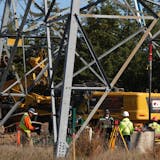LE SUEUR, Minn. – Nearly two years after going online, an innovative, municipally owned power plant that burns methane from agricultural waste is generating only a faction of its promised electricity.
The $45 million plant, built partly with federal aid in this city 50 miles southwest of Minneapolis, also is producing something its promoters said it wouldn't — stink.
"It is like living next to a giant poop plant," said Katie Terwedo, the closest neighbor to the Hometown BioEnergy plant that began operating in late 2013.
Although the plant has steadily increased its power output, it remains well short of its goal of generating electricity for 12 hours or more per day. In the first three quarters of 2015, it operated at just 12 percent of its capacity, or about three hours per day on average.
The plant's owner, Minnesota Municipal Power Agency (MMPA), and its operator, Minneapolis-based Avant Energy, express confidence in the technology. They said that odors are being addressed and that ramping up to full-scale power generation was expected to take time.
"We would be very happy to reach 12 hours [of daily power generation] in five or six years," said Derick Dahlen, CEO of Avant Energy, which gets an unspecified payment to operate the plant and collected a share of the $11 million in fees to plan and build it.
At that pace, the plant would reach its expected generating output around 2020, the state's deadline for most Minnesota utilities to get 20 percent of their electricity from renewable sources.
The challenge, executives said, is finding the best mix of agricultural wastes. They're dumped into tanks called anaerobic digesters, where bacteria produce methane, or natural gas, to run power generators. An innovative feature of the Le Sueur plant is three fabric domes that store methane so that generators can run only when electricity demand is high.


